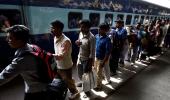The Union home ministry and the labour ministry have asked state governments to coordinate with the chief labour commissioner’s (CLC’s) office to give a comprehensive data of all the migrant workers by April 11.

The central government has begun one of the most comprehensive exercises to map migrant workers scattered across the country -- in relief camps, on their employers’ premises, or in clusters where they reside.
The government wants to create a database of millions of such workers to ascertain whether a relief package could be announced for the most affected segment of the workforce due to the national lockdown to contain the spread of coronavirus (Covid-19), a senior labour and employment ministry official said.
The Union home ministry and the labour ministry have asked state governments to coordinate with the chief labour commissioner’s (CLC’s) office to give a comprehensive data of all the migrant workers by April 11.
“As you all are well aware that a huge number of migrant workers is impacted due to the lockdown in view of spread of Covid-19 … In view of above a comprehensive data in respect of the migrant workers are urgently required within three days,” CLC Rajan Verma said in a letter dated April 8 to all his regional officers.
The data is to be collected from three sources primarily: Relief camps or shelters (district-wise); employers whose labour is in-situ at workplace; and from localities where migrant workers generally reside in a cluster. The data will be taken from relief camps operated by non-governmental organisations and companies as well.
The database will ascertain whether the migrant workers have bank accounts or bank accounts opened under the Pradhan Mantri Jan Dhan scheme, whether the workers get benefits of free gas cylinders for cooking under the Pradhan Mantri Ujjwala Yojana, and their Aadhaar numbers.
The data will be segregated on the basis of occupation too. The list of occupations include agriculture, domestic work, rickshaw pulling, security service, work at brick kilns, automobile work, food processing, and building and construction work.
Sector-wise data will be sought from the employers. The piece of information is supposed to be collected by district administrations in states. The labour commissioners will be working in coordination with them “for obtaining the details of migrant workers”.
The government will attempt to map the pattern of migration and workers will be asked about their last place of residence and their native place.
A government official said data collection was an important step towards the government announcing contingency measures for the migrant workers in case the lockdown was extended.
Since data collection may pose a challenge and the government requires to collect it in a short duration, officials of the Employees’ Provident Fund Organisation and Employees’ State Insurance Corporation (ESIC), along with labour welfare commissioners, will also be roped in for help in some states.
“The database will also help the central government to make arrangements to transport workers to their homes from relief camps or bring them to cities for work, if they desire. But this idea is at a nascent stage as it will depend on the final decision on lockdown,” another government official said.
The official added that the government also wanted to prepare itself for contingency measures in case there were coronavirus-infected people living in shelter homes.
According to the central government’s estimates, part of its response to a petition filed by activists Anjali Bhardwaj and Harsh Mander in the Supreme Court, around 1.03 million people are residing in relief camps. But this might be an underestimation because the information was not captured from all the shelter homes.
Additionally, at least 1.5 million workers are being provided shelter by employers across the country.
“Workers in the unorganised sector, which is about 90 per cent of our workforce, has been left in the lurch because they have lost their source of income as businesses have come to a halt. Their savings are meagre and the companies cannot step in to help as they have also been impacted. The government should provide a helping help to them by transferring them minimum wages,” Bhardwaj said.
The 21-day lockdown, beginning March 25, led a reverse migration with workers leaving cities and going back to their villages as industries were shut and paying house rent or taking care of basic needs became a challenge, apart from health concerns.
According to official estimates, 500,000-600,000 workers had to walk back home on foot because public transport was not available to them. They travelled miles on foot to reach their villages.
Hundreds of thousands of migrant workers are still living in shelter homes set up by various state governments in India, while the rest are under quarantine facility before they are allowed to meet their families.











